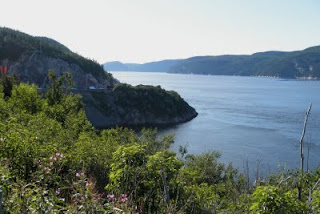
Tonight we're in Tadoussac, Quebec, on the north side of the St. Lawrence, where it meets the Saguenay River.
Getting here in the last couple of days at times reminded us of the TV show "The Amazing Race", from not being able to find campgrounds (we lost sight of the fact that Monday is a provincial holiday in much of Canada - something akin to either July 4th or Labor Day weekends in the U.S.) to trying to make sense of ferry schedules across the St. Lawrence.
We spent much of today waiting for a one hour ferry that was scheduled to leave Rimouski, Quebec at 2:45; we were told to be there around 12:30, but the ferry didn't actually sail until 3:45. No matter - we sat in the parking lot in our self-contained home, reading, relaxing, and having lunch – not all that much different than sitting in our own living room at home.

Getting here in the last couple of days at times reminded us of the TV show "The Amazing Race", from not being able to find campgrounds (we lost sight of the fact that Monday is a provincial holiday in much of Canada - something akin to either July 4th or Labor Day weekends in the U.S.) to trying to make sense of ferry schedules across the St. Lawrence.
We spent much of today waiting for a one hour ferry that was scheduled to leave Rimouski, Quebec at 2:45; we were told to be there around 12:30, but the ferry didn't actually sail until 3:45. No matter - we sat in the parking lot in our self-contained home, reading, relaxing, and having lunch – not all that much different than sitting in our own living room at home.

In any event, we've only been here a few hours but are beginning to think that this area is one of eastern North America's best kept secrets. The view as we were ready to cross the Saguenay River on yet another ferry gave us a hint of what we may see in the next few days:
























